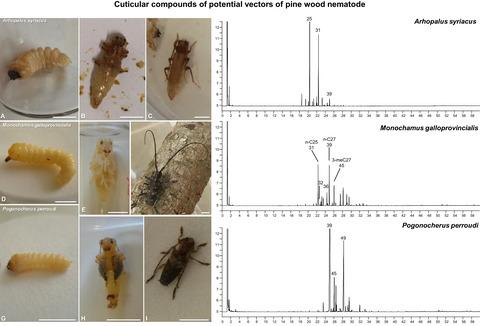当前位置:
X-MOL 学术
›
Entomol. Exp. Appl.
›
论文详情
Our official English website, www.x-mol.net, welcomes your
feedback! (Note: you will need to create a separate account there.)
Characterization of cuticular compounds of the cerambycid beetles Monochamus galloprovincialis, Arhopalus syriacus, and Pogonocherus perroudi, potential vectors of pinewood nematode
Entomologia Experimentalis et Applicata ( IF 1.4 ) Pub Date : 2021-01-26 , DOI: 10.1111/eea.13017 Elsa Gonçalves 1 , Ana Cristina Figueiredo 1 , José G. Barroso 1 , Jocelyn G. Millar 2 , Joana Henriques 3, 4 , Edmundo Sousa 3, 5 , Luís Bonifácio 3, 5
Entomologia Experimentalis et Applicata ( IF 1.4 ) Pub Date : 2021-01-26 , DOI: 10.1111/eea.13017 Elsa Gonçalves 1 , Ana Cristina Figueiredo 1 , José G. Barroso 1 , Jocelyn G. Millar 2 , Joana Henriques 3, 4 , Edmundo Sousa 3, 5 , Luís Bonifácio 3, 5
Affiliation

|
In Portugal, dozens of bark and wood‐boring beetle species have been recorded colonizing Pinus pinaster Aiton (Pinaceae), the main conifer species affected by pine wilt disease (PWD). However, its causal agent, the pinewood nematode (PWN), Bursaphelenchus xylophilus (Steiner & Buhrer) Nickle (Parasitaphelenchidae), has been recovered only from the black pine sawyer, Monochamus galloprovincialis (Olivier) (Coleoptera: Cerambycidae). To understand the mechanisms underlying this specific relationship, our goal was to characterize the cuticular compounds (CCs) of three of the most abundant wood‐boring cerambycids, M. galloprovincialis, Arhopalus syriacus (Reiter), and Pogonocherus perroudi (Mulsant) Villiers, colonizing infested P. pinaster. Three methods of extracting CCs were assessed: (1) headspace solid phase microextraction (SPME), (2) extraction with organic solvent (pentane or ethanol), and (3) hydrodistillation. Pentane extraction was most effective, using pooled samples of each of the insects’ developmental stages. Extracts were analysed by gas chromatography‐mass spectrometry (GC‐MS) to identify compounds, and by GC for quantification. The pentane extracts contained predominantly straight‐chain (n‐C) and methyl‐branched hydrocarbons (meC). Cluster analysis defined two main clusters, with cluster A comprising A. syriacus samples dominated by n‐C23 (7‐39%), n‐C25 (9‐31%), and n‐C27 (5‐11%). Pogonocherus perroudi and the larvae from M. galloprovincialis grouped in sub‐cluster B1, characterized by high proportions of n‐C27 (20‐52%), n‐C29 (4‐18%), and 3‐meC27 (8‐18%). Sub‐cluster B2 included the remaining M. galloprovincialis samples, dominated by n‐C27 (10‐14%), n‐C25 (8‐10%), 5‐meC25 (9‐16%), 2‐meC26 (6‐12%), and 3‐meC27 (6‐10%). The CC profiles of the various species may play a key role in triggering the movement of PWN from the tree to callow adults of the specific insect vector, among all insects colonizing infested host trees. Identification of key components would potentially allow the development of valuable tools to manage PWD, for example, in a lure to quickly detect PWN in a tree, or conversely, by treatment of felled wood with PWN repellents to disrupt PWN transfer to its insect vector, breaking the transmission cycle.
中文翻译:

松材线虫的潜在载体-cerambycid甲虫Monochamus galloprovincialis,Arhopalus syriacus和Pogonocherus perroudi的表皮化合物的表征
在葡萄牙,已经记录了数十个树皮和枯木甲虫物种定居在Pinus pinaster Aiton(Pinaceae)上,Pinace pinaster Aiton是受松树枯萎病(PWD)影响的主要针叶树种。然而,它的致病剂的松材线虫(PWN),松材线虫(斯坦纳&Buhrer)镍(Parasitaphelenchidae),一直是只能从黑松墨天牛,回收松贻贝(奥利弗)(:天牛科鞘翅目)。要理解这背后特定关系的机制,我们的目标是表征三个最丰富的钻木天牛,的的表皮化合物(CCS)贻贝,Arhopalus木槿(赖特)和Pogonocherus perroudi(M牛)维利耶斯,定居于被侵染的P. pinaster。评估了三种提取CC的方法:(1)顶空固相微萃取(SPME),(2)用有机溶剂(戊烷或乙醇)萃取和(3)加氢蒸馏。戊烷提取是最有效的方法,使用每个昆虫发育阶段的汇总样本。提取物通过气相色谱-质谱(GC-MS)分析以鉴定化合物,并通过GC进行定量。戊烷萃取主要含有直链(Ñ -C)和甲基-支链烃(MEC)。聚类分析限定的两个主要簇,与簇A,其包含A.木槿由主导样品Ñ -C23(7-39%),Ñ -C25(9-31%),和n C27(5-11%)。Pogonocherus perroudi和M. galloprovincialis的幼虫归入亚群B1,其特征是n- C27(20-52%),n- C29(4-18%)和3-meC27(8-18%)的比例很高)。子簇B2包含剩余的贻贝的样品,由主导Ñ -C27(10-14%),Ñ-C25(8-10%),5-meC25(9-16%),2-meC26(6-12%)和3-meC27(6-10%)。在定居于被感染宿主树的所有昆虫中,各种物种的CC谱在触发PWN从树向特定昆虫媒介的call叫成虫的移动中起关键作用。识别关键成分可能会潜在地开发出管理PWD的有价值的工具,例如,诱使它们快速检测树木中的PWN,或者相反,通过用PWN驱虫剂处理砍伐的木材,破坏PWN向其昆虫媒介的转移,中断传输周期。
更新日期:2021-02-02
中文翻译:

松材线虫的潜在载体-cerambycid甲虫Monochamus galloprovincialis,Arhopalus syriacus和Pogonocherus perroudi的表皮化合物的表征
在葡萄牙,已经记录了数十个树皮和枯木甲虫物种定居在Pinus pinaster Aiton(Pinaceae)上,Pinace pinaster Aiton是受松树枯萎病(PWD)影响的主要针叶树种。然而,它的致病剂的松材线虫(PWN),松材线虫(斯坦纳&Buhrer)镍(Parasitaphelenchidae),一直是只能从黑松墨天牛,回收松贻贝(奥利弗)(:天牛科鞘翅目)。要理解这背后特定关系的机制,我们的目标是表征三个最丰富的钻木天牛,的的表皮化合物(CCS)贻贝,Arhopalus木槿(赖特)和Pogonocherus perroudi(M牛)维利耶斯,定居于被侵染的P. pinaster。评估了三种提取CC的方法:(1)顶空固相微萃取(SPME),(2)用有机溶剂(戊烷或乙醇)萃取和(3)加氢蒸馏。戊烷提取是最有效的方法,使用每个昆虫发育阶段的汇总样本。提取物通过气相色谱-质谱(GC-MS)分析以鉴定化合物,并通过GC进行定量。戊烷萃取主要含有直链(Ñ -C)和甲基-支链烃(MEC)。聚类分析限定的两个主要簇,与簇A,其包含A.木槿由主导样品Ñ -C23(7-39%),Ñ -C25(9-31%),和n C27(5-11%)。Pogonocherus perroudi和M. galloprovincialis的幼虫归入亚群B1,其特征是n- C27(20-52%),n- C29(4-18%)和3-meC27(8-18%)的比例很高)。子簇B2包含剩余的贻贝的样品,由主导Ñ -C27(10-14%),Ñ-C25(8-10%),5-meC25(9-16%),2-meC26(6-12%)和3-meC27(6-10%)。在定居于被感染宿主树的所有昆虫中,各种物种的CC谱在触发PWN从树向特定昆虫媒介的call叫成虫的移动中起关键作用。识别关键成分可能会潜在地开发出管理PWD的有价值的工具,例如,诱使它们快速检测树木中的PWN,或者相反,通过用PWN驱虫剂处理砍伐的木材,破坏PWN向其昆虫媒介的转移,中断传输周期。











































 京公网安备 11010802027423号
京公网安备 11010802027423号